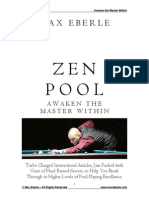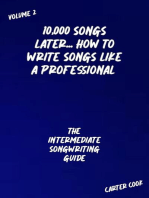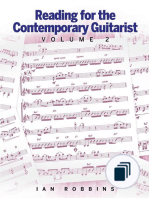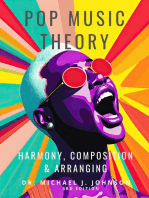Using Binary Numbers in Music: Vi Hart Music Department Stony Brook University Stony Brook, NY, USA
Using Binary Numbers in Music: Vi Hart Music Department Stony Brook University Stony Brook, NY, USA
Uploaded by
NEmanja DjordjevicCopyright:
Available Formats
Using Binary Numbers in Music: Vi Hart Music Department Stony Brook University Stony Brook, NY, USA
Using Binary Numbers in Music: Vi Hart Music Department Stony Brook University Stony Brook, NY, USA
Uploaded by
NEmanja DjordjevicOriginal Title
Copyright
Available Formats
Share this document
Did you find this document useful?
Is this content inappropriate?
Copyright:
Available Formats
Using Binary Numbers in Music: Vi Hart Music Department Stony Brook University Stony Brook, NY, USA
Using Binary Numbers in Music: Vi Hart Music Department Stony Brook University Stony Brook, NY, USA
Uploaded by
NEmanja DjordjevicCopyright:
Available Formats
Using Binary Numbers in Music
Vi Hart Music Department Stony Brook University Stony Brook, NY, USA E-mail: vi@vihart.com Abstract
Composing using binary numbers as rhythms can create music that is both interesting and accessible. I shall demonstrate, using whimsical examples, that binary numbers and music can indeed live in harmony.
Why use Binary Numbers?
Binary numbers used as rhythms (not to be confused with binary rhythms) can be used in music to create a mathematical aspect to a piece which can be heard and appreciated by mathematicians, yet still be pleasant to the ears of the uninitiated. Even someone who has never heard of binary numbers can still understand the patterns on an intuitive level. Binary numbers, especially those affiliated with computer science, have a structure which goes very well with the standard forms of music. Mathematics and constraints. Artists love to come up with limitations which they must figure out how to work around. Working with tight constrictions requires creativity, giving the artist opportunity to stretch her limits, show off, and have fun. Bachs fugues and canons are still known and admired because of the incredible things he managed to do with such strict forms. Escher did similar things with art, using mathematical rules to create his work [1]. A French literary group, Oulipo (Ouvroir de Littrature Potentielle, or Workshop of Potential Literature), also enjoy writing using rules, for example: writing a novel without the letter E, or writing snowball sentences, where the first word has one letter, the second has two letters, then three and so on [2]. Many composers find ways to work meaningful numbers into their pieces. Alban Berg found importance in the number 23, and also gave significance to other numbers, which he then reflected in his pieces. The score to George Crumbs Black Angels is saturated with the numbers 7 and 13, from the number of movements to the number of notes in phrases, and different combinations of instruments are used methodically [3]. Schoenberg developed serialism, organizing pitches into a row and using them systematically. The possible transpositions and inversions of the row can be organized into matrices, a technique used by Pierre Boulez and Peter Maxwell Davies. John Cage used chance, rolling dice to determine the pitch and length of notes. Iannis Xenakis, inspired by architecture, created musical curves out of straight glissandi [4]. Indeed, throughout the 20th century, music relied increasingly on mathematics. However, most melodies composed from such rules are appreciable only by academics. Often the math isnt recognizable to the listener, and only an unpleasant sounding string of notes remains. It should be noted that very few techniques of this type directly generate music; most are organizational tools which still leave many musical choices to the composer. The technique which is the topic of this paper constrains only the rhythm of one or more voices, leaving the choice of notes up to the composer. In the following examples, I compose using not just the rhythm derived from binary numbers, but also using other compositional choices based on the character of the numbers. The examples can be heard online at [5].
Binary Numbers as Rhythm. Let 1 be a note and 0 be a rest. Thus a number becomes a rhythm! The numbers one through eight, in binary, are shown in Figure 0. Below each number is the corresponding rhythm. In computer science, binary numbers are usually seen in groups of eight bits (a byte), which happens to fit perfectly into a 4/4 measure if we assign bits to eighth notes. Powers of two are involved in the usual form of western music, where four or eight bar phrases might make up a 16 measure section of a 64 measure song. This creates a constraint on the rhythm, but leaves the composer free to choose the melody.
Figure 0: Binary numbers 1-8 above corresponding rhythms. Ways to use Binary Numbers as Rhythms
ASCII Code. There is a computer standard, ASCII, for encoding data into binary. Every letter of the alphabet (as well as other characters) has a corresponding 8 bit ASCII code. While mathematically arbitrary, it is a natural encoding for people familiar with Computer Science. This means that one measure can encode one letter (if youre using eighth notes). Figure 1 shows a self-referential string quartet where each instrument plays the letters of its name as the rhythm. The code for each lowercase letter used begins with 011, and the following five digits are the position of the letter in the alphabet. Lowercase a, then, is 01100001. The melody is unconstrained. If one heard the segment without knowing there was any math behind the rhythms, one would still hear how each measure starts the same way and how the violin and viola play the same rhythm for the first four measures. Even when not consciously noted, patterns make a piece cohesive. A random string of ones and zeroes would not have nearly as nice an effect.
Figure 1: A string quartet where each instrument plays its own name in ASCII.
This is a great way to hide secret messages and suggests various types of musical steganography. Famous examples are the motives which Bach and Shostakovich used to sign their name, Bach with the notes BACH (Bb A C B), and Shostakovich with his initials: DSCH (D Eb C B). The German system of note names uses B rather than Bb, and H instead of B. Using Eb to represent S is a precedent created by Shostakovich, which I follow in Figure 2. Brahms, Schumann, Elgar, Berg, and others have also used the letter names of pitches to sign or dedicate their work. The technique of encoding binary into music improves upon this, allowing messages of any length and with any letter. Of course, both techniques could be used at once. As seen in Figure 2, which is a section of a longer piece, I hide a name within the notes of a lyrical melody, while the rhythm of the chords spell it in ASCII. Also note that instead of 1 meaning play and 0 meaning rest, a 0 means hold the previous note, to allow a more lyrical melody.
Figure 2: sasha is hidden in both note names and rhythm. Equations. One can add numbers by making an equation where a number played by one instrument, plus a number played by a second instrument, equal a number played by both together, as seen in Figure 3. It shows the creation of the Fibonacci sequence by adding previous terms to get new ones. Each eighth beat represents a 0 or 1. A 1 must start a note but it may be held over any number of 0s, and all other 0s are rests. Because previous terms are used again in addition, there is a structure to the form. The numbers grow from beginning to end of the piece, and so the trend is an increasing number of ones with earlier entries, making the piece gain momentum and excitement as it progresses. The beginning of the Fibonacci sequence can also be found hidden in the piano part, where middle C is 1, D is 2, E is 3, G is 5, and so on.
Figure 3: The Fibonacci sequence.
One could write music to a whole variety of sequences, and many sequences have a number of unintended side-effects. By simultaneously using two different but related sequences in different voices, connections can be heard between them (for example, if you multiply a binary number by two, the aural effect is a metric shift one note to the left). The Online Encyclopedia of Integer Sequences [6] is an excellent resource for this, and one I have used in the composition of examples not shown in this paper.
Fractional Binary Numbers. Binary numbers with fractional parts have an additional problem: how to indicate the binary point. One could use bar lines or a musical cue, such as having all the bits played in a different range or by a different instrument. In the following example (Figure 4), has been turned into music. The first two bits which make up three (binary 11) are a pickup, and from the first measure onwards the violin and flute play the non-repeating bits for, in theory, an infinitely long piece (unfortunately this example only shows four measures of it). Also new in this segment is that both instruments play the same number, with the flute sounding on ones and the violin on zeroes. While is functionally a random number generator, the compositional choices made using this random number are very specific to this number, and a different number (such as e) could lead the composer to an altogether different piece. When notes skip back and forth between two voices, one must be careful to give shape to the groups of notes which are together (as in the end of the first measure in the flute) and keep the music from sounding too jumpy when the parts are very disjoint (such as in the second measure). It is not merely a matter of writing a single melody and then separating it out into two voices.
Figure 4: A segment using to 64 binary places.
Other Possibilities. There are many other encodings possible from binary strings to rhythms, which I have used in examples not shown here. Instead of making an eighth of a beat correspond with a 0 or a 1, more control could be had over the rhythm by making a 1 a note of any chosen length and 0 a beat of rest. Also, the roles of the digits could be switched to create a similar piece, where zeroes sound and ones do not. The two important things are to know where the zeroes and ones are, and to know where numbers begin and end. There are always more numbers and patterns to explore, more ways of encoding information, and more ways to turn ones and zeroes into notes. Composers are always looking for inspiration, challenges, and tools. Creating music using binary numbers is a lot of fun, and I have enjoyed trying to discover different ways of composing using them. The results have often been unexpected, with new side-effects constantly popping up. There is a challenge in making an arbitrary rhythm into coherent music, and even greater challenge comes from adding additional constraints: new and related rules that govern the relationships between numbers or measures. It helps one to look at composing in a new way, breaking old patterns by forcing a start from a different direction than usual. It is almost addictive, and I know I wont be able to resist sneaking secret messages into future compositions.
References
[1] [2] [3] [4] Hofstadter, Douglas R. Gdel, Escher, Bach: An Eternal Golden Braid. New York: Basic, 1979. Gardner, Martin. Penrose Tiles to Trapdoor Ciphers. New York: W H Freeman, 1989. Burkholder, J. Peter, et al. A History of Western Music. New York: W.W. Norton & Co., 2006. Cross, Jonathan. Composing with numbers: sets, rows, and magic squares. In Music and Mathematics. Fauvel, John, et al. Oxford: University Press, 2003. [5] Hart, Vi. http://vihart.com/bridges2008 [6] Online Encyclopedia of Integer Sequences: http://www.research.att.com/~njas/sequences/index.html [7] Rothstein, Edward. Emblems of Mind. New York: Avon Books, 1995.
You might also like
- Polychords: The Big Book ofDocument30 pagesPolychords: The Big Book ofGian Franco67% (3)
- Welcome to the Jungle: A Success Manual for Music and Audio FreelancersFrom EverandWelcome to the Jungle: A Success Manual for Music and Audio FreelancersNo ratings yet
- Max Eberle - Zen PoolDocument72 pagesMax Eberle - Zen PoolAndrew BimbusNo ratings yet
- Music Basics A quick reference & study guide for the rudiments of musicFrom EverandMusic Basics A quick reference & study guide for the rudiments of musicNo ratings yet
- Mandolin Songwriter’s Chord Progression Bible: Mandolin Songwriter’s Chord Progression Bible, #3From EverandMandolin Songwriter’s Chord Progression Bible: Mandolin Songwriter’s Chord Progression Bible, #3No ratings yet
- An Incomplete Crash Course in Contemporary Music Theory: The FundamentalsFrom EverandAn Incomplete Crash Course in Contemporary Music Theory: The FundamentalsRating: 5 out of 5 stars5/5 (1)
- Give Your Worship: How To Write Christian Songs In 1 Hour Without Forcing InspirationFrom EverandGive Your Worship: How To Write Christian Songs In 1 Hour Without Forcing InspirationNo ratings yet
- Chord Theory: For Beginners - Bundle - The Only 2 Books You Need to Learn Chord Music Theory, Chord Progressions and Chord Tone Soloing TodayFrom EverandChord Theory: For Beginners - Bundle - The Only 2 Books You Need to Learn Chord Music Theory, Chord Progressions and Chord Tone Soloing TodayNo ratings yet
- Read This Before You Join a Band!: My Life as a Touring and Session MusicianFrom EverandRead This Before You Join a Band!: My Life as a Touring and Session MusicianRating: 1 out of 5 stars1/5 (1)
- The Full Songwriting Guide: 10,000 Songs Later... How to Write Songs Like a ProfessionalFrom EverandThe Full Songwriting Guide: 10,000 Songs Later... How to Write Songs Like a ProfessionalNo ratings yet
- Finding Chords to Match the Notes In Your Melody: A Manual for Songwriters and MusiciansFrom EverandFinding Chords to Match the Notes In Your Melody: A Manual for Songwriters and MusiciansRating: 4 out of 5 stars4/5 (1)
- Musician 2.0: How to earn money writing music to sell it onlineFrom EverandMusician 2.0: How to earn money writing music to sell it onlineNo ratings yet
- Harmony to All: For Professionals and Non-Professional MusiciansFrom EverandHarmony to All: For Professionals and Non-Professional MusiciansNo ratings yet
- The Jazz Guitarist's Handbook: An In-Depth Guide to Chord Symbols Book 1: The Jazz Guitarist's Handbook, #1From EverandThe Jazz Guitarist's Handbook: An In-Depth Guide to Chord Symbols Book 1: The Jazz Guitarist's Handbook, #1No ratings yet
- Testimony: The Memoirs of Dmitri ShostakovichFrom EverandTestimony: The Memoirs of Dmitri ShostakovichRating: 4 out of 5 stars4/5 (50)
- The Basic Songwriting Guide: 10,000 Songs Later... How to Write Songs Like a Professional, #1From EverandThe Basic Songwriting Guide: 10,000 Songs Later... How to Write Songs Like a Professional, #1No ratings yet
- The Intermediate Songwriting Guide: 10,000 Songs Later... How to Write Songs Like a Professional, #2From EverandThe Intermediate Songwriting Guide: 10,000 Songs Later... How to Write Songs Like a Professional, #2No ratings yet
- Mandolin Songwriter’s Chord Progression Bible: Mandolin Songwriter’s Chord Progression Bible, #5From EverandMandolin Songwriter’s Chord Progression Bible: Mandolin Songwriter’s Chord Progression Bible, #5No ratings yet
- Philip “Flip” Gordon: Jazz Compositions Volume 2: Zodiac Project: Secrets D’HistoireFrom EverandPhilip “Flip” Gordon: Jazz Compositions Volume 2: Zodiac Project: Secrets D’HistoireNo ratings yet
- Lessons in Music Form: A Manual of Analysis of All the Structural Factors and Designs Employed in Musical CompositionFrom EverandLessons in Music Form: A Manual of Analysis of All the Structural Factors and Designs Employed in Musical CompositionNo ratings yet
- The Master Arpeggio System for Jazz Improvisation: V2.0 Expanded EditionFrom EverandThe Master Arpeggio System for Jazz Improvisation: V2.0 Expanded EditionNo ratings yet
- Mandolin Songwriter’s Chord Progression Bible: Mandolin Songwriter’s Chord Progression Bible, #1From EverandMandolin Songwriter’s Chord Progression Bible: Mandolin Songwriter’s Chord Progression Bible, #1No ratings yet
- Ukulele Songwriter’s Chord Progression Bible - Book 2: Ukulele Songwriter’s Chord Progression Bible, #2From EverandUkulele Songwriter’s Chord Progression Bible - Book 2: Ukulele Songwriter’s Chord Progression Bible, #2No ratings yet
- Figure 0: Binary Numbers 1-8 Above Corresponding Rhythms. Ways To Use Binary Numbers As RhythmsDocument3 pagesFigure 0: Binary Numbers 1-8 Above Corresponding Rhythms. Ways To Use Binary Numbers As RhythmsdiNo ratings yet
- Binary MusicDocument2 pagesBinary MusicdiNo ratings yet
- Figure 4: A segment using π to 64 binary places.: Mathematics. Fauvel, John, et al. Oxford: University Press, 2003Document1 pageFigure 4: A segment using π to 64 binary places.: Mathematics. Fauvel, John, et al. Oxford: University Press, 2003diNo ratings yet
- Barbara Kobs Math 1030 Final ProjectDocument10 pagesBarbara Kobs Math 1030 Final Projectapi-114225366No ratings yet
- Elements of The ScoreDocument11 pagesElements of The ScoreScribdTranslationsNo ratings yet
- Magical Mathematics of MusicDocument9 pagesMagical Mathematics of MusicAhyessa Castillo100% (1)
- Six Little Piano PiecesDocument7 pagesSix Little Piano PiecesthrowNo ratings yet
- What Is The Musical AlphabetDocument12 pagesWhat Is The Musical AlphabetMohammd SaifNo ratings yet
- Collectif1806-1966 BOOTH S HANDBOOK OF COCKTAILS AND MIXED DRINKS E PDFDocument192 pagesCollectif1806-1966 BOOTH S HANDBOOK OF COCKTAILS AND MIXED DRINKS E PDFNEmanja Djordjevic100% (1)
- Before The Blueprint - Peter AndersonDocument96 pagesBefore The Blueprint - Peter AndersonNEmanja DjordjevicNo ratings yet
- A Primer For Logic and ProofDocument119 pagesA Primer For Logic and ProofNEmanja DjordjevicNo ratings yet
- A Primer For Logic and ProofDocument119 pagesA Primer For Logic and ProofNEmanja DjordjevicNo ratings yet































































